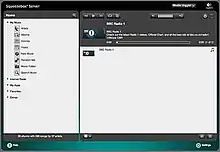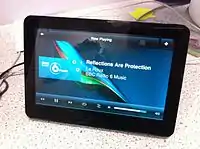Logitech Media Server
Logitech Media Server (formerly SlimServer, SqueezeCenter and Squeezebox Server) is a streaming audio server supported by Logitech (formerly Slim Devices), developed in particular to support their Squeezebox range of digital audio receivers.
 Logitech Media Server Web Interface | |
| Developer(s) | Logitech |
|---|---|
| Stable release | 8.3.1
/ February 17, 2023 |
| Written in | Perl |
| Operating system | Debian, Windows, macOS |
| Platform | RPM package, Perl |
| Type | Streaming audio server |
| License | GNU General Public License |
| Website | mysqueezebox |
The software is designed for streaming music over a network, allowing users to play their music collections from virtually anywhere there is an Internet connection. It supports audio formats including MP3, FLAC, WAV, Ogg, Opus, and AAC, as well as transcoding. It can stream to both software and hardware receivers, including the various Squeezebox models, as well as any media player capable of playing MP3 streams. Plugins from Logitech and third-party sources are also supported, allowing additional functionality to be added, and there is integration with Logitech's mysqueezebox.com online service. Logitech Media Server supports grouping clients in order to synchronize playback among all clients within a group.[1]
Logitech Media Server is free software, released under the terms of the GNU General Public License. While no longer distributed in conjunction with any Logitech hardware product, LMS continues to be developed.
Compatible players
Hardware

Logitech's own Squeezebox hardware players existed in a variety of configurations, offering wired and wireless Ethernet, analog and digital audio outputs, touchscreen interfaces and a variety of remote controlled options. Logitech discontinued their hardware players in 2012.
Logitech Media Server also works with networked music players, such as the Roku SoundBridge M1001, although Logitech does not officially support these competing products. Chumby devices also support streaming music from a Logitech Media Server, as does the Rio Receiver when running replacement software to emulate the SliMP3 device, although it is limited to modest bitrates (<128kps). In late 2015 support was added via a plugin to use Google's Chromecast Audio device as a headless player which can then be connected to any audio system or powered speakers.
Recently the O2 Joggler has proven a popular device for running Logitech's open source SqueezePlay software, providing a similar interface to the Squeezebox Touch on a 7" display.
The Raspberry PI, using the piCorePlayer streams from LMS and in some cases LMS is run on the Raspberry PI too.[2]
SqueezeAMP, a free open source hardware player.[3]
Software
SqueezePlay is based on SqueezeOS, the operating system that drives the hardware devices Squeezebox Duet, Radio and Touch. Written in Lua, it is also open-source software and sees regular updates through Logitech's SVN releases. There is also a free software emulator version of the Squeezebox, called Softsqueeze, which is written in Java and can be run easily as an applet inside a web page. A third player, SqueezeSlave, is also available, which operates similarly but without any display. SqueezeSlave is designed to be run on a server connected to an amplifier/speakers, and can be controlled through the standard Logitech Media Server web interface. At this time, SqueezeSlave is incompatible with Logitech's Spotify plugin due to a lack of support for 'direct streaming'.[4]
In 2012, work began on Squeezelite, a cross-platform, headless, LMS client that supports playback synchronization, gapless playback, direct streaming (for use with Spotify, etc.), and playback at various sampling rates.[5]
In 2019, Squeezelite has been ported[6] to the ESP32 WiFi/BT chipset and works on WROVER and ESP-A1S module or any board that includes an ESP32 and 4MB of SRAM (e.g. SqueezeAMP)
There is as well three free open source "bridges" that allow UPnP/DLNA, ChromeCast and AirPlay devices to appear as regular SB players. AirPlay devices can be synchronized with other SB players. Chromecast groups are recognized as well as Sonos (UPnP) group, but they can only play synchronously within their own respective brand.
Server hardware and plugins
The Logitech Media Server software is written in Perl, and will run on Linux, Microsoft Windows, Apple Macintosh, BSD, and piCorePlayer platforms.
Logitech Media Server itself can run on a number of NAS devices, such as QNAP Turbo NAS, Synology Disk Station, Netgear ReadyNAS, Buffalo Linkstation, Linksys NSLU2, Thecus N5200 & N7700, Xtreamer eTRAYz and any device running FreeNAS software. Logitech Media Server also comes pre-installed on the VortexBox Linux distribution and VortexBox appliance. This generally results in lower energy consumption than running Logitech Media Server on a personal computer, whilst offering the same feature set (albeit with a slightly less responsive web interface under certain circumstances). Some NAS devices may require more effort than others to get Logitech Media Server running, though. Logitech only supports the Netgear ReadyNAS NAS devices.
Plugins
There are numerous plug-ins and device drivers available for Logitech Media Server, which include features such as support for automation systems from Clare Controls, AMX LLC and Crestron Electronics. Plugins also provide access to additional services, such as the live radio and 'listen-again' features of BBC Sounds in the UK.
Alexa
As of September 2019, Logitech Media Server is controllable by a full-function Alexa skill (called 'MediaServer'[7]) available in the en-US and en-GB locales. In addition to allowing voice control of hardware and software Squeezebox players, this also allows streaming audio from LMS to an Amazon Echo device for playback.
References
- "Synchronization". Logitech Squeezebox Wiki. Retrieved 19 February 2013.
- https://www.picoreplayer.org
- "philippe44/SqueezeAMP: all-in-one audio board, works specially well with LogitechMediaServer". GitHub. Retrieved 2023-03-12.
- "Squeezeslave + Spotify plugin". Squeezebox Community Forums. 30 September 2010. Retrieved 28 January 2011.
- "Announce: Squeezelite - a small headless squeezeplay emulator for linux (alsa only)". Squeezebox Community Forums. 2 November 2012. Retrieved 28 January 2013.
- "sle118/squeezelite-esp32: ESP32 Music streaming based on Squeezelite, with support for multi-room sync, AirPlay, Bluetooth, Hardware buttons, display and more". GitHub. 2022-12-08. Retrieved 2023-03-12.
- "[Announce] 'MediaServer' *certified* Alexa skill for LMS". 25 September 2019.